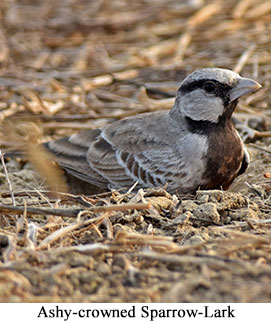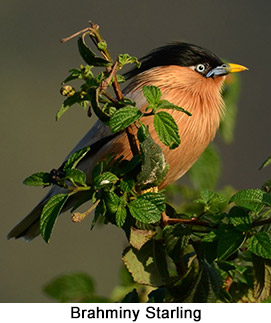INDIA BIRDS & TIGERS TOUR
Tour Description

INDIA
BIRDING TOUR
ANY TIME*
| Duration: | 18 days, 17 nights |
| Group Size: | 2-6 |
| Anytime Price: | $6395 |
| Group Price: | $5750 |
| Single Suppl: | $700 |
| Est #Species: | 375-400 |
| Pace: | Easy |
| Difficulty: | Easy |
| * This tour is available for any dates of your choosing provided guide services and accommodations are available. | |
DAY 1 - ARRIVAL, SULTANPUR NATIONAL PARK, & BASAI WETLAND
Following morning arrival in Delhi, we'll go birding at two superb wetland sites within 50km of the city at Sultanpur and nearby Basai where we expect to see large numbers of Bar-headed Goose, Indian Spot-billed Duck, and Greater Flamingo along with Gray-headed Swamphen and White-tailed Lapwing. The surrounding scrub and dry grasslands offer additional species such as Gray Francolin, Eurasian Hoopoe, Eurasian Wryneck, Bank Myna, Bluethroat and two regional specialties, Brook's Leaf-Warbler and Sind Sparrow. Night at Pride Plaza Aerocity in Delhi.
DAY 2 - TRANSFER & JHALANA LEOPARD RESERVE
We'll depart early for the 5-hour drive to Jaipur, located southwest of Delhi. We're likely to see Black Kite, Indian Roller, Rose-ringed Parakeet, and Common Myna enroute. That afternoon we'll visit the Jhalana Leopard Reserve, a densely wooded site in the Aravalli Hills. This reserve is the best place in India to see Leopards, which are easiest to find in dry season during March and April. Other mammals we may well see are Striped Hyena, Chital, Sambar, Nilgai and others. Mammals are not the only attraction in the reserve. Possible birds include Yellow-footed Green-Pigeon, Black Eagle, Dusky Eagle-Owl, Spotted Owlet, Brown-capped Pygmy Woodpecker, Yellow-crowned Woodpecker, Indian Golden Oriole, and Indian Paradise-Flycatcher. Night at Ramada Jaipur.
DAY 3 - ARAVALLI HILLS & TRANSFER
After a morning jeep safari back in the leopard reserve, we'll drive to Ranthambhora, a 4-hour drive to the southeast of Delhi. Afternoon we'll be birding scrublands outside the national park boundary. This area is heavily grazed and covered with a scattering of thorny bushes, ideal habitat for Chestnut-bellied Sandgrouse, Painted Sandgrouse, Sirkeer Malkoha, Indian Courser, Great Gray Shrike, Rufous-tailed Lark, Ashy-crowned Sparrow-Lark, Greater Short-toed Lark, Desert Wheatear, Variable Wheatear, Streaked Weaver, Baya Weaver, and White-capped Bunting. Night at Tiger Den in Ranthambhore.
DAY 4 - RANTHAMBORE NATIONAL PARK
We'll spend two full days on safari in Ranthambore National Park. The park was once a hunting preserve of the maharajas and is dotted with ruins and dominated by a crumbling fortress on a cliff overlooking the reserve. The habitat is predominantly tropical dry deciduous forest and is home to a healthy population of Bengal Tigers. This park is the most reliable place in India to see tigers, and the best time to see them is end of dry season in March and April when they congregate near permanent water. We'll be birding from an open-topped vehicle while searching the area designated to us by park rangers for our safari in the park. Because of the large number of visitors, vehicles are given designated routes to reduce congregation that may disturb the tigers. Birding from the vehicle is surprisingly good. We hope to be allocated an outlying safari route outside the core zone of the park where fewer vehicles are present, allowing us to see birds that tend to be shy around humans. Specialties in the park include the endemic Painted Spurfowl and Sulphur-bellied Warbler. Six species of vultures are possible in the park despite the catastrophic decline in these populations due to widespread veterinary use of the drug Diclofenac. Widely distributed birds likely to be seen include Indian Peafowl, White-naped Woodpecker, Plum-headed Parakeet, Rufous Treepie, and Jungle Babbler. The numerous lakes scattered throughout the reserve are home to Indian Spot-billed Duck, Great Thick-knee, River Tern, Black-bellied Tern, Asian Woolly-necked Stork, Painted Stork, and Black-headed Ibis. In addition to tigers, we should encounter other mammals such as possibly Northern Plains Gray Langur, perhaps Sloth Bear, Wild Boar, Chital, Sambar, and Indian Gazelle. Night at Tiger Den in Ranthambore.
DAY 5 - RANTHAMBORE NATIONAL PARK & TRANSFER
We'll return to Ranthambore National Park for another safari drive during this morning. Afternoon transfer to Bharatpur, a 6-hour drive. Night at Hotel Sunbird or Ibis House Farm in Bharatpur.
DAY 6 - CHAMBAL RIVER & TAJ MAHAL
Morning boat trip along the Chambal River, located an hour outside Bharatpur. Development along the river has been traditionally discouraged because of an ancient myth that branded the river as unholy, so this river is one of the least polluted waterways in India. The main target bird along the river is the scarce and patchily distributed Indian Skimmer. Other birds found along the river are Brown Crake, Indian Thick-knee, River Lapwing, River Tern, Black-bellied Tern, Painted Stork, Black-headed Ibis, Red-naped Ibis, and Egyptian Vulture. The river is also home to Smooth-coated Otter and Ganges River Dolphin along with Marsh Crocodile and the odd, pot-nosed Gharial. For about half its length, the river is flanked by muddy ravines that are re-formed by soil erosion each monsoon. The sparse vegetation in these ravines is mainly tropical dry scrub forest and is home to Brooks's Leaf Warbler, Yellow-eyed Babbler, Desert Wheatear, and Crested Bunting. Agricultural areas nearby are home to Sirkeer Malkoha, Eurasian Wryneck, and Yellow-eyed Babbler. On our drive to or from the Chambal River, we'll stop to visit the Taj Mahal in Agra. Night at Hotel Sunbird or Ibis House Farm in Bharatpur.
DAY 7 - KEOLADEO NATIONAL PARK
This day will be devoted to exploring the man-made wetlands of Keoladeo National Park, one of India's finest bird reserves. The shallow lakes and ponds were originally created by the maharajas to support duck hunting. Up to 150 species of birds are can be seen in a single day within the park. Birding in the park is along a network of roads closed to traffic through the center of the park and on various trails along the edges of wetlands. Wetland birds we expect to see include Bar-headed Goose, Graylag Goose, Knob-billed Duck, Indian Spot-billed Duck, Red-crested Pochard, Sarus Crane, White-tailed Lapwing, Black-necked Stork, Painted Stork, Black Bittern, Red-naped Ibis, and Eurasian Spoonbill. Patches of sandy acacia scrub and deciduous woodlands along some trails are home to White-tailed Iora, White-eared Bulbul, Eastern Orphean Warbler, Brahminy Starling, Orange-headed Thrush, Tickell's Thrush, Bluethroat, Siberian Rubythroat, Taiga Flycatcher, and Red-breasted Flycatcher. Possible raptors include Indian Spotted Eagle, Steppe Eagle, and Imperial Eagle. We also expect to find Large-tailed Nightjar, Indian Scops-Owl, and Dusky Eagle-Owl in day roosts. Night at Hotel Sunbird or Ibis House Farm in Bharatpur.
DAY 8 - TRANSFER NORTH
Depart early for Jim Corbett National Park in the northern state of Uttarakhand, about an 8 hour drive. This region is situated at the base of the Himalayan Mountains. Enroute we'll do a little roadside birding to break up the drive. We should encounter some new species as we reach the northern foothills such as Crested Kingfisher, Lesser Racket-tailed Drongo, Spotted Forktail, Plumbeous Redstart, Plain Flowerpecker, and Orange-bellied Leafbird. Night at Tiger Camp near Jim Corbett Natonal Park.
DAY 9-11 - JIM CORBETT NATIONAL PARK
Jim Corbett National Park is India's oldest national park. We'll have 3 full days to bird the area. The park is a tiger reserve but the tall grass makes it difficult to actually see tigers there. The park is in a transition zone between the Indo-Gangetic plains and the foothills of the Himalayas. The habitats include mixed deciduous forest, bamboo stands, and grassy pastures. It's winter home to altitudinal and Palearctic migrants in addition to a high diversity of resident species. It has the highest diversity of raptors in India.
Much of the best birding is in dense forests at Mohan and Kumeria on the fringes of the park. There we'll be looking for Brown Fish-Owl, Tawny Owl, Great Slaty Woodpecker, Common Green-Magpie, Gray-bellied Tesia, Chestnut-headed Tesia, and Long-billed Thrush. Inside the park we'll be birding from open-topped jeeps. The vast floodplain grasslands are home to Hen Harrier, Pallid Harrier, Pied Harrier, Golden-headed Cisticola, White-throated Bushchat, and Red Avadavat. We'll look for the scarce Ibisbill along the Kosi River. We should see Wallcreeper on cliff faces. Other specialities in the park and surrounding areas include Kalij Pheasant, Pallas's Fish-Eagle, Lesser Fish-Eagle, Gray-headed Fish-Eagle, Himalayan Flameback, Lesser Yellownape, Greater Yellownape, Collared Falconet, Red-breasted Parakeet, Black Bulbul, Black-crested Bulbul, Himalayan Bulbul, Rufous-bellied Niltava, and Orange-bellied Leafbird. Though tiger sightings are unlikely, we should see some other mammals such as Asian Elephant, Northern Plains Gray (Hanuman) Langur, Wild Boar, Hog Deer, Sambar, and perhaps other mammals in the park. Nights at Tiger Camp outside the park.
DAY 12 - TRANSFER & PANGOT AREA
Depart early for the 4 hour drive into the middle elevation foothills of the Himalayas to the small town of Pangot. This village is at about 7000ft in elevation and is a hub for birding nearby locales in the region. We'll bird the forested mountainside along the highway during the transfer. Possibilities include Black-headed Jay, Red-billed Blue-Magpie, Gray-winged Blackbird, Blue Whistling-Thrush, Himalayan Bluetail, and Russet Sparrow. If it's a clear day, we'll have stunning views of the Himalayas enroute. Afternoon we'll bird sites near Pangot. Possibilities include Collared Owlet, Rufous-bellied Woodpecker, Himalayan Woodpecker, Yellow-browed Tit, the endangered Gray-crowned Prinia, Whiskered Yuhina, and Fire-breasted Flowerpecker. Feeders at our lodge attract Black Francolin, Black-headed Jay, Striated Laughingthrush, Streaked Laughingthrush, Rufous-chinned Laughingthrush, and White-throated Laughingthrush. Night at Pinewood Cottages in Pangot.
DAY 13-14 - NAINITAL AREA
We'll have two full days to bird around Pangot in Nainital County. We'll depart early to look for Koklass Pheasant and, higher up, the Himalayan endemic Cheer Pheasant. Other montane specialties we'll seek out include Hill Partridge, Collared Owlet, Sunda Owlet, Himalayan Owl, Himalayan Woodpecker, Yellow-browed Tit, Scaly-breasted Cupwing, Black-chinned Babbler, Variegated Laughingthrush, Chestnut-crowned Laughingthrush, Rufous Sibia, Spot-winged Grosbeak, Scarlet Finch, Pink-browed Rosefinch, Dark-breasted Rosefinch, and Yellow-breasted Greenfinch. At higher altitudes we hope to see Bearded Vulture, Himalayan Griffon, Alpine Accentor, and Altai Accentorf. We're also likely to find Gorals, a form of mountain goat, at these altitudes. Nights at Pinewood Cottages in Pangot.
DAY 15 - TRANSFER & BHIMTAL AREA
Morning transfer downslope to the small tourist village of Bhimtal via the colonial-era hill station at Nainital. Despite development around the village, patches of open grass and scrub-filled ravines provide habitat for some good birding. Specialties include Great Barbet, Blue-throated Barbet, Siberian Rubythroat, Himalayan Rubythroat, Golden Bush-Robin, Rufous-gorgeted Flycatcher, Blue-fronted Redstart, Blue-capped Redstart, Rufous-breasted Accentor, and Black-throated Accentor. Night at Birder's Den in Bhimtal.
DAY 16 - SATTAL & FOOTHILLS
We'll have all day to bird the foothills around Bhimtal including Sattal, once home to a tea plantation and Christian "ashram" during the British colonial era. The dense forests in the surrounding hills are largely intact and provide excellent birding. Forest specialties include Speckled Piculet, Himalayan Flameback, the shy Nepal Cupwing, Blue-winged Minla, White-crested Laughingthrush, Gray-winged Blackbird, Small Niltava, and Rufous-bellied Niltava. Along the river at Chaffi we'll search for Spotted Forktail and Slaty-backed Forktail. At Kainichi Dam we should find Crested Kingfisher, Brown Dipper, Little Forktail, Plumbeous Redstart, and White-capped Redstart. We may well encounter mixed species feeding flocks moving through the forest, Typical species in these flocks are Green-backed Tit, Buff-barred Warbler, Lemon-rumped Warbler, Gray-hooded Warbler, Black-faced Warbler, Black-throated Tit, White-tailed Nuthatch, Chestnut-bellied Nuthatch, Bar-tailed Treecreeper, Fire-breasted Flowerpecker, Black-throated Sunbird, and Green-tailed Sunbird. Many other interesting birds are also possible, including Black Francolin, Asian Barred Owlet, White-bellied Erpornis, Gray-backed Shrike, Gray Treepie, Himalayan Bulbul, Rusty-cheeked Scimitar-Babbler, Chestnut-crowned Laughingthrush, Rufous Sibia, Red-billed Leiothrix, White-throated Laughingthrush, and Black-throated Thrush. Night at Birder's Den in Bhimtal.
DAY 17 - BHIMTEL AREA & TRANSFER
We'll do some final birding around Bhimtel before departing for Delhi. We'll do a bit of roadside birding looking for any species missed earlier during the 7 hour drive. Night at Pride Plaza Aerocity in Delhi.
DAY 18 - END OF TOUR
Tour ends after breakfast at the international airport in Delhi.
TOUR NOTES
For a group of 4 persons, the group price applies with one vehicle and the anytime price applies with two vehicles. An extra day can be added at Ranthambore for birding and tiger viewing at the additional charge of $400/person.
ADDITIONAL INFO
(Not on Menu Above)
BIRDING LOCALES















